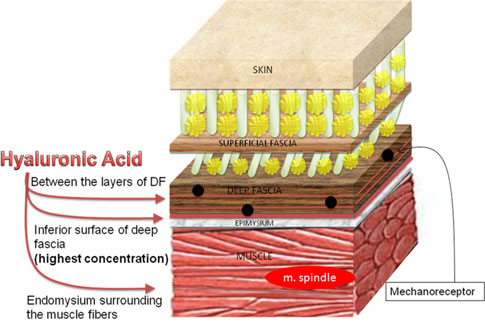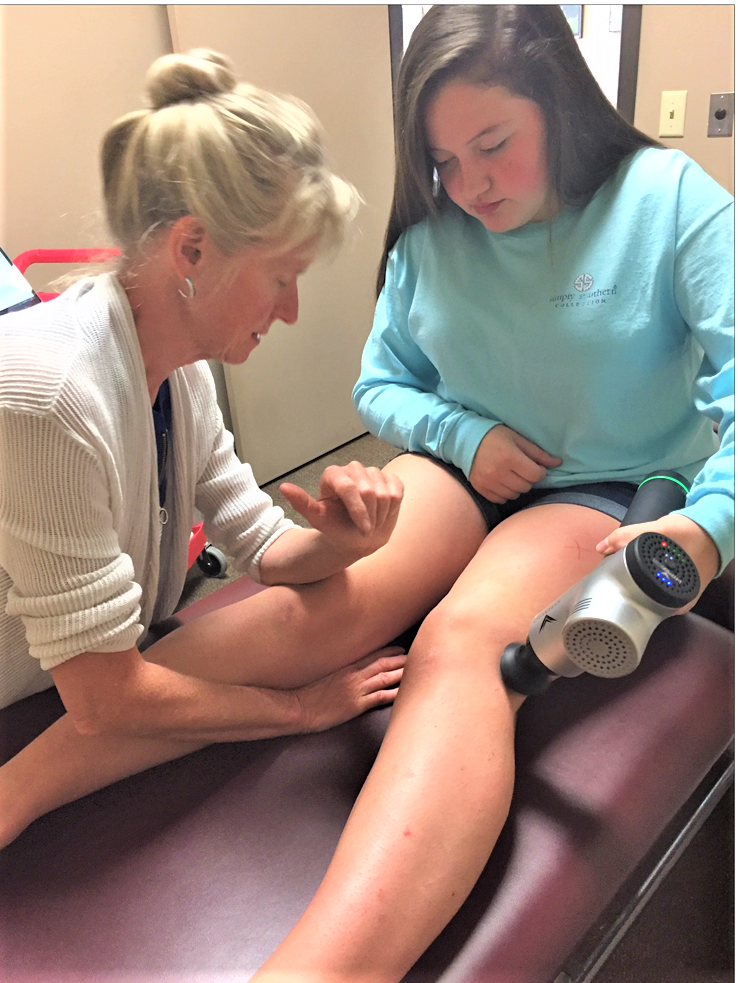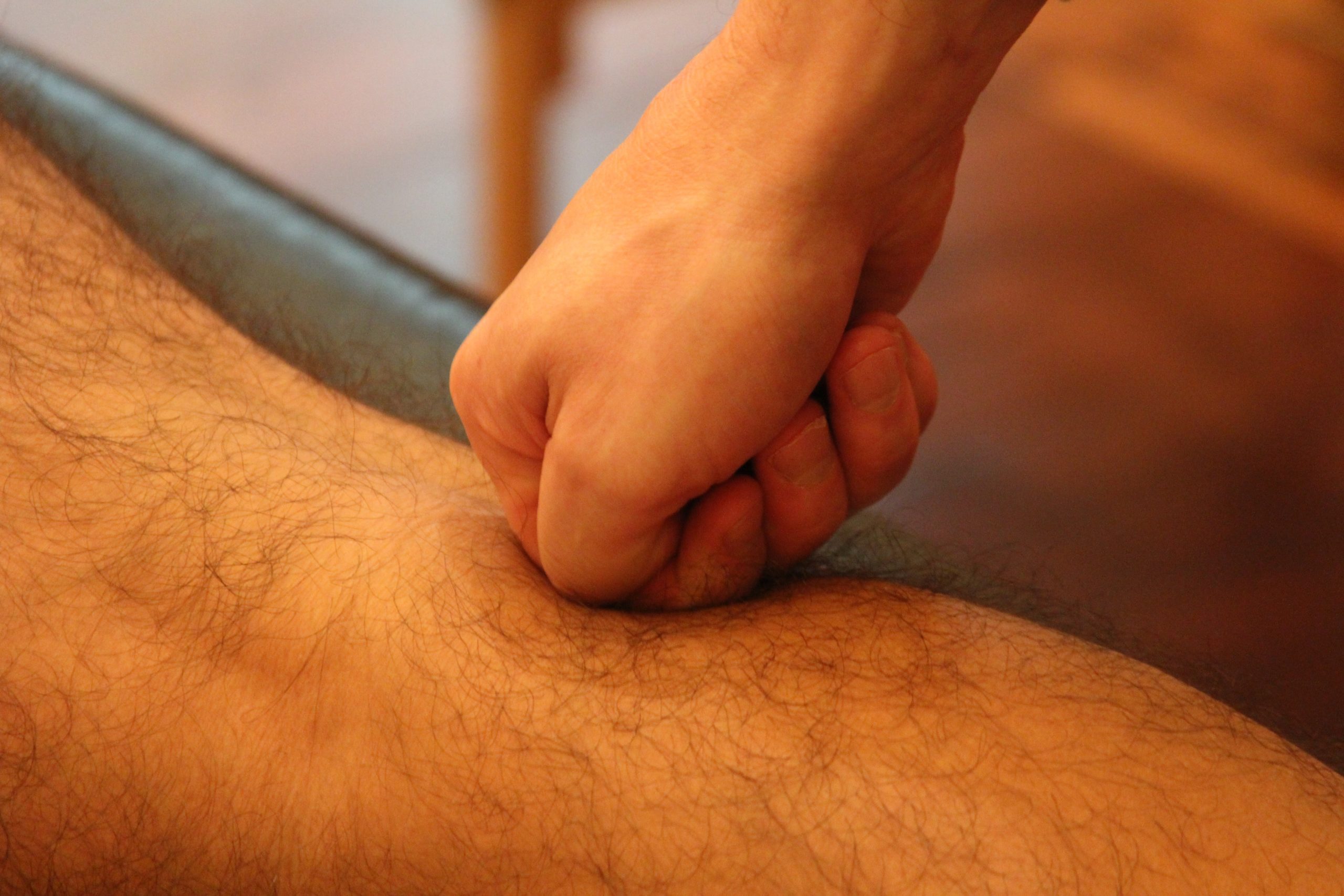What Is Fascia in the Body?
Fascia is the white-ish tissue that can be thin and filmy in some places and very thick and tough in others. It is comprised largely of collagen fiber bundles, interspersed with varying amounts of elastic fibers dictated by location in the body and function. Continuous throughout the body from head to toe, front to back, and right to left, there is no tissue that is not surrounded and influenced by fascia: bone, nerve, muscle, blood vessel, lymphatic, bowel, bladder, stomach, heart, and reproductive organs, just to name a few.
Fascia permeates our musculoskeletal system encasing muscles by groups, individual muscles, and even each single muscle fiber in an uninterrupted tensile network. This arrangement is thought to impact movements of the trunk and extremities in all three planes: frontal, sagittal, and transverse, as well as combinations of these planes in diagonals. It also encases our internal organs, and, based on the highly innervated nature of this internal fascia, is thought to play a role in the movement and normal function of the internal organs (peristalsis).
 The presence of the biochemical hyaluronan (also known as hyaluronic acid or HA) creates vital spacing between fascial layers allowing for healthy passage of blood vessels, lymph ducts, and nerves. HA also provides lubrication between fascial layers, which allows for normal movement throughout the musculoskeletal system as well as the internal organs that perform our involuntary bodily functions. Fascia is highly innervated, communicating with the nervous system to perceive tension, pain, position, and movement. Its pervasive nature situates it perfectly to play a strategic role in governing movement – be it movement of the bowel, bladder, or bone. Historically, the important role fascia plays in healthy tissues and bodily function has been grossly underestimated. Research is helping to improve our understanding.
The presence of the biochemical hyaluronan (also known as hyaluronic acid or HA) creates vital spacing between fascial layers allowing for healthy passage of blood vessels, lymph ducts, and nerves. HA also provides lubrication between fascial layers, which allows for normal movement throughout the musculoskeletal system as well as the internal organs that perform our involuntary bodily functions. Fascia is highly innervated, communicating with the nervous system to perceive tension, pain, position, and movement. Its pervasive nature situates it perfectly to play a strategic role in governing movement – be it movement of the bowel, bladder, or bone. Historically, the important role fascia plays in healthy tissues and bodily function has been grossly underestimated. Research is helping to improve our understanding.
What Can Go Wrong: Fascia Densification
Research reveals that fascia, much like the muscles and organs it enfolds, is subject to overload— certainly with trauma, but also with everyday activities. Twenty to thirty minutes of a sustained posture or activity has been shown to modify connective tissues and lead to the development of myofascial trigger points. In a similar manner, overload such as injury, repetitive movements, or immobilization, alters HA and converts it from a space-creating lubricant in the extracellular matrix to a space-occupying adherent. This compromises the vital space and slide between the fascial layers, creating what is called a fascial densification. The sustained presence of densifications between fascial layers alters movement in the underlying muscle/organ and can cause a variety of problems including:
- Pain
- Restricted range of motion
- Loss of strength/endurance, sensation, balance, and function
- Wear and tear on joints, discs, tendons, meniscus, cartilage, bursa, organs – basically, everything caught in the middle
- Compromised function of structures surrounded by fascia (muscles, blood and lymph vessels, internal organs, and nerves).
Fascia Treatment: Fascial Manipulation-Stecco® (FM)
The characteristic of the connective tissues that leads to dysfunction – deformation in response to overload – is also the attribute that will reverse the problem. Exploiting the plasticity and malleability of the tissues is the key to resolving densifications and restoring space and lubrication between fascial layers. A technique called Fascial Manipulation-Stecco® (FM) can be very helpful for this.
FM involves the application of pressure and friction at specific densification sites where muscle and fascial forces converge to control movement of a body segment in a particular direction, or where an internal organ is affixed to the trunk wall. These fascial problems are identified and resolved in a straightforward manner:
1. The Body’s History
 History is key in the FM method and leads to identifying remote areas that may be influencing the primary problem. This is especially true when complaints are “idiopathic.” The body has a reason for doing everything. Like a detective, we have to piece together the evidence to arrive at a reasonable hypothesis as to what is driving the problem. This may involve old injuries, fractures, surgeries, past problems that seem to have fully resolved – everything and anything is fair game!
History is key in the FM method and leads to identifying remote areas that may be influencing the primary problem. This is especially true when complaints are “idiopathic.” The body has a reason for doing everything. Like a detective, we have to piece together the evidence to arrive at a reasonable hypothesis as to what is driving the problem. This may involve old injuries, fractures, surgeries, past problems that seem to have fully resolved – everything and anything is fair game!
2. Identifying the Restricted Body Segment
Identifying the body segment and movement/organ function that is restricted, painful, stiff, or weak with simple range of movement tests. In the case of internal organ dysfunction, movement may not highlight dysfunction, and identification of current or past problems may be more helpful. Palpation is then essential in identifying which points in the chosen body segments, called Centers of Coordination (CC) or Centers of Fusion (CF), are densified and causing dysfunction. Skill and strategy – much like a chess game – are key to determining which points to treat for an optimal result.
3. Restoration of Vital Space and Slide Between Fascial Layers
 FM is typically performed manually with an elbow or knuckle at the chosen CC or CF. While incredibly effective, FM is also intense. Sometimes prepping tissues may be helpful to expedite tissue modification and minimize pain, not to mention the practitioner’s workload. Percussion and vibration devices, heat, laser, dry needling, cupping, and a host of other techniques can be helpful.
FM is typically performed manually with an elbow or knuckle at the chosen CC or CF. While incredibly effective, FM is also intense. Sometimes prepping tissues may be helpful to expedite tissue modification and minimize pain, not to mention the practitioner’s workload. Percussion and vibration devices, heat, laser, dry needling, cupping, and a host of other techniques can be helpful.
Ultimately it is not as critical which tool is used for therapeutic intervention, but more importantly to identify the tissue being targeted and having a strategy for where to apply a therapeutic intervention. The site of pain / main complaint is not always the best place to intervene, and focus here may lead to suboptimal or unsustainable results. The best place to apply a therapeutic intervention may be quite remote to the main complaint. This is where the FM strategy shines in giving the clinician a method to approach the person from a total body perspective. This includes past injuries or problems, surgeries, and seemingly unrelated issues in remote parts of the body – musculoskeletal or internal organ.
Retest with repeat of the same faulty movements initially identified. In the case of internal organ dysfunction, change may not be immediately apparent and time may be needed to identify improvement.
When to Consider Fascial Dysfunction
Fascial dysfunction should be considered when musculoskeletal/internal organ problems occur or return for no apparent reason or do not respond. It should also be considered when conventional medical tests (such as X-ray, MRI, colonoscopy, diagnostic ultrasound) are negative, inconclusive, or do not align with the clinical picture. This is likely due to the fact that the focus of most studies is a joint or organ. Yet often the problem is not the organ or joint, but the fascial environment in which the structure is trying to function.
The FM approach embraces a total body concept, based on the continuous nature of fascia throughout the body. It provides an explanation as to how pain in one area may be influenced by a problem in another area. In other words, where it hurts is not always where the problem is and may necessitate treatment at a site remote to the main complaint.
What Conditions Can FM® Treat?
The beauty of working with the FM model is that it provides a viable treatment option that addresses the root cause of many problems instead of just masking the symptoms. By addressing faulty biomechanics through changing movement, FM provides a viable option for addressing pain and dysfunction without the use of medication or surgery. The continuous nature of fascia throughout the body allows FM to treat patients with an astonishing array of dysfunctions such as:
- Osteoarthritis of the spine and extremities
- Degenerative disc/joint disease and pain
- Low back and neck pain, whiplash
- Rotator cuff pain and problems, frozen shoulder
- Sciatica pain
- Carpal Tunnel Symptoms
- Headache, temporomandibular joint
- Plantar fasciitis issues and heel spurs
- Pelvic problems (pain, bowel/bladder issues, IBS, dysmenorrhea, prostatitis)
- Restless Leg Syndrome
- Dizziness and Vertigo
- Athletic injuries and sports performance
- Additional conditions not listed here
Colleen Whiteford, PT, DPT, OCS, CMTPT


